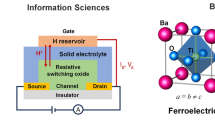Abstract
Mildred Dresselhaus was one of the most renowned physicists, material scientists, and electrical engineers of our time. She made vital contributions to research on graphite and graphite intercalation compounds, graphene, carbon fibers and nanotubes, fullerenes, and thermoelectric effects of nanostructures. Mildred Dresselhaus was considered the leading expert on carbon materials, and was popularly known in the scientific circles as the “Queen of Carbon”. Her immense contributions to the field of carbon materials ushered in the era of carbon nanoscience and technology.
Similar content being viewed by others
Suggested Reading
L Madsen, Successful Women Ceramic and Glass Scientists and Engineers: 100 Inspirational Profiles, Wiley 640, 2016.
M Hargittai, Women Scientists: Reflections, Challenges, and Breaking Boundaries, New York: Oxford University Press, xiii, 363 pages, 2015.
P R Schroeder, M S Dresselhaus, and A Javan, Location of Electron and Hole Carriers in Graphite from Laser Magnetoreflection Data, Physical Review Letters, 20(23): pp.1292–1295, 1968.
M S Dresselhaus and G Dresselhaus, Intercalation Compounds of Graphite, Advances in Physics, 30(2): pp. 139–326, 1981.
M S Dresselhaus and G Dresselhaus, New Directions in Intercalation Research, Molecular Crystals and Liquid Crystals Science and Technology Section A — Molecular Crystals and Liquid Crystals, 244, pp.1–12, 1994.
Eric A Rohlfing, D M Cox and A Kaldor, Production and Characterization of Supersonic Carbon Cluster Beams, Journal of Chemical Physics, 81, pp.3322–3332, 1984.
H W Kroto et al., C60: Buckminsterfullerene, Nature, 318, p.162, 1985.
R Saito et al., Electronic-Structure of Graphene Tubules Based on C-60, Physical Review B, 46(3), pp.1804–1811, 1992.
R Saito et al., Electronic-Structure of Chiral Graphene Tubules, Applied Physics Letters, 60(18), pp.2204–2206, 1992.
M A Pimenta et al., Raman Modes of Metallic Carbon Nanotubes, Physical Review B, 58(24), pp.R16016–R16019, 1998.
S Iijima and T Ichihashi, Single-shell Carbon Nanotubes of 1-nm diameter, Nature, 363, p.603, 1993.
M S Dresselhaus, Fifty Years in Studying Carbon-Based Materials, Physica Scripta, T146, 2012.
K Nakada et al., Edge State in Graphene Ribbons: Nanometer Size Effect and Edge Shape Dependence, Physical Review B, 54(24), pp.17954–17961, 1996.
R Saito et al., Raman Spectra of Graphene Ribbons, Journal of Physics-Condensed Matter, 22(33), 2010.
X Ling et al., The Renaissance of Black Phosphorus, Proceedings of the National Academy of Sciences of the United States of America, 112(15), pp.4523–4530, 2015.
X Ling et al., Raman Enhancement Effect on Two-Dimensional Layered Materials: Graphene, h-BN and MoS2, Nano Letters, 14(6), pp.3033–3040, 2014.
M Kalbac et al., Large Variations of the Raman Signal in the Spectra of Twisted Bilayer Graphene on a BN Substrate, Journal of Physical Chemistry Letters, 3(6), pp.796–799, 2012.
L D Hicks and M S Dresselhaus, Effect of Quantum-Well Structures on the Thermoelectric Figure of Merit, Physical Review B, 47(19), pp.12727–12731, 1993.
M S Dresselhaus et al., New Directions for Low-dimensional Thermoelectric Materials, Advanced Materials, 19(8), pp.1043–1053, 2007.
American Physical Society, https://doi.org/www.aps.org/.
https://doi.org/news.mit.edu/2013/mildred-s-dresselhaus-fund
The Kavli Prize, [cited 2018; Available from: https://doi.org/kavliprize.org/prizes-and-laureates/laureates/mildred-s-dresselhaus.
US Department of Energy, Office of Science, [cited 2018; Available from: https://doi.org/science.energy.gov/fermi/award-laureates/2010s/dresselhaus/.
National Science and Technology Medals Foundation, https://doi.org/www.nationalmedals.org/laureates/mildred-s-dresselhaus.
American Physical Society, Millie Dresselhaus Fund for Science & Society.
Author information
Authors and Affiliations
Corresponding author
Additional information
Jayeeta Lahiri, Assistant Professor, School of Physics, University of Hyderabad is interested in studying surface and interface properties of low-dimensional materials like graphene (2D), hexagonal BN (2D), and graphene nanoribbons (1D).
Rights and permissions
About this article
Cite this article
Lahiri, J. The Queen of Carbon!. Reson 24, 263–272 (2019). https://doi.org/10.1007/s12045-019-0778-4
Published:
Issue Date:
DOI: https://doi.org/10.1007/s12045-019-0778-4




